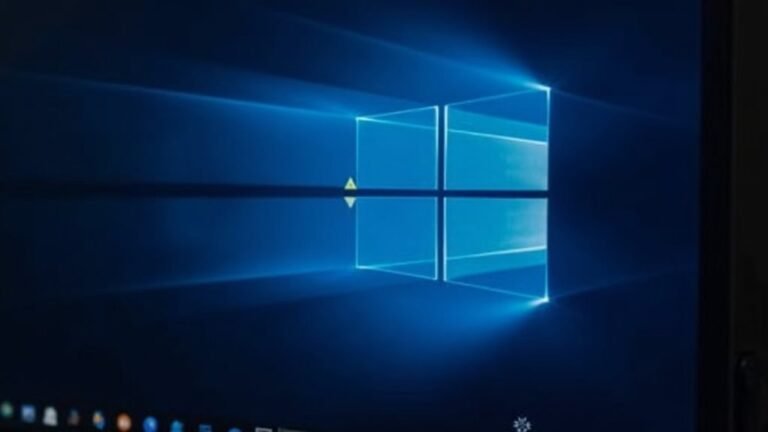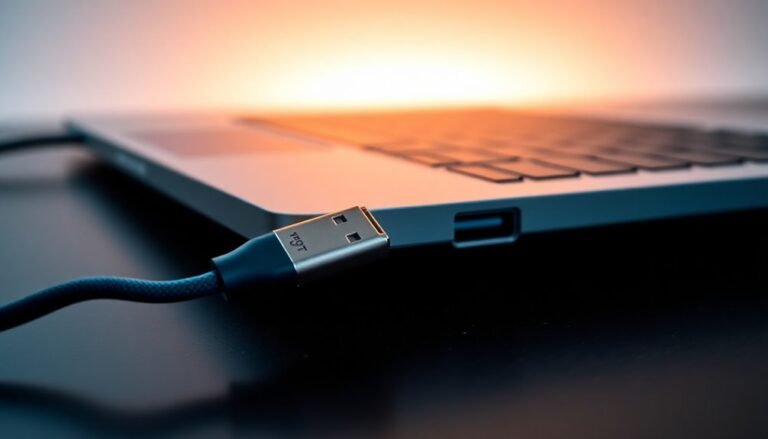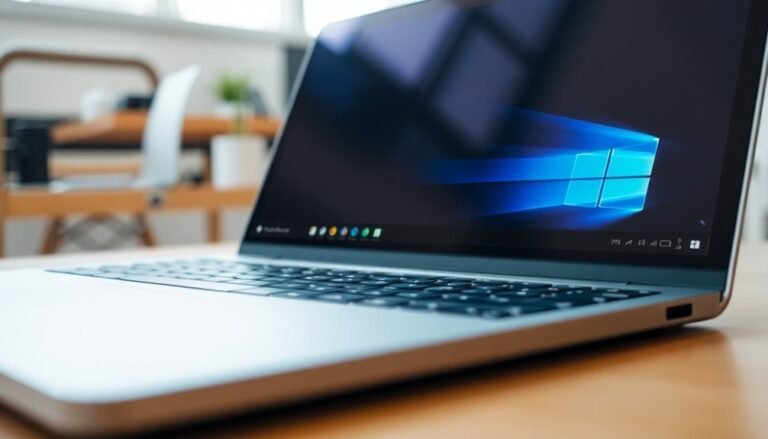Windows 11 WiFi 6 Slow: Fix WiFi 6 Performance Issues
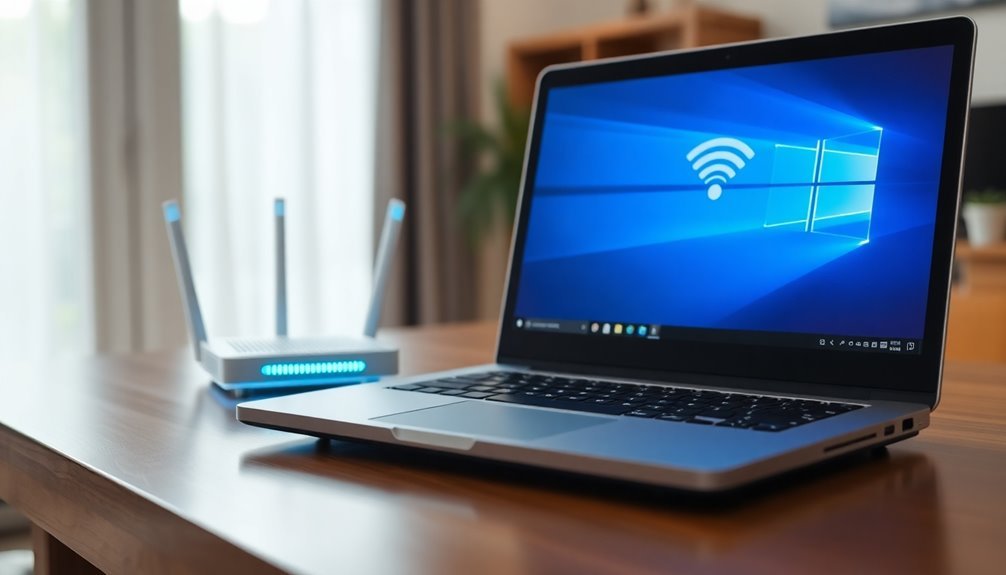
To fix slow WiFi 6 on Windows 11, first update your WiFi adapter drivers and router firmware to the latest versions. This ensures compatibility and improved performance.
Optimize adapter settings by disabling legacy standards and setting the channel width to 80 or 160 MHz. These changes help maximize your connection speed.
On your router, enable WPA3 for enhanced security and auto channel selection to reduce interference. Using public DNS services like Google or Cloudflare can improve browsing speed.
Run diagnostic tools to identify any interference or hardware faults. Each step targets common causes, but there are additional measures you can take to maximize your WiFi 6 performance.
Updating WiFi 6 Drivers and Router Firmware
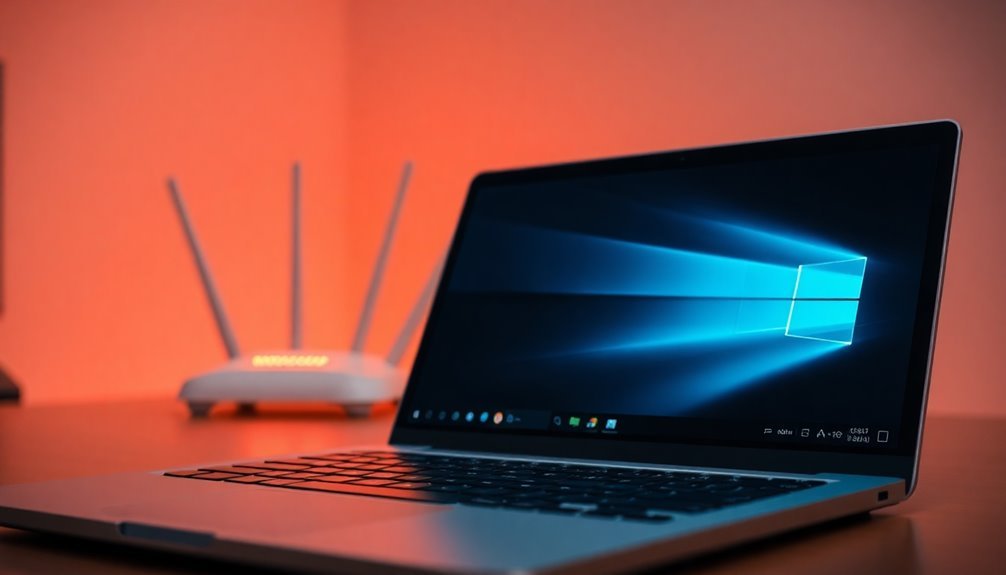
Optimize Your WiFi 6 Experience: Update Drivers and Router Firmware for Windows 11
To fully unlock the speed and stability benefits of WiFi 6 on your Windows 11 device, keeping your WiFi drivers and router firmware up to date is crucial. Outdated drivers can limit performance and cause connectivity issues. Updated drivers help maintain strong and stable WiFi connections, ensuring you get the most from your network hardware.
How to Update WiFi 6 Drivers on Windows 11
- Open Device Manager by right-clicking the Start button.
- Find your WiFi adapter under “Network adapters.”
- Right-click the adapter and select “Update driver.”
- Choose “Search automatically for updated driver software” to let Windows find the latest version.
For best results, visit your laptop or WiFi card manufacturer’s official website to download the most recent WiFi 6 driver—especially if you use Intel hardware. Intel’s WiFi 6 drivers, such as version 23.150.0, include important feature updates and security patches. After installing, reboot your PC to enable new enhancements.
Update Your Router Firmware for Enhanced WiFi 6 Performance
Access your router’s admin panel and check the manufacturer’s site regularly for firmware updates. Firmware upgrades fix bugs, boost WiFi 6 compatibility, and eliminate speed bottlenecks.
Keeping your router’s firmware current ensures a stronger, more reliable wireless connection.
Optimizing Windows 11 Network Settings for WiFi 6
Optimize Windows 11 Network Settings for Maximum WiFi 6 Performance
To unlock the full potential of your WiFi 6 network on Windows 11, it’s crucial to optimize your network settings effectively. Start by configuring the TCP autotuning level to “normal” to enhance data flow and enable Receive-Side Scaling (RSS) for balanced network load distribution across multiple CPU cores.
For better handling of high-bandwidth connections, switch the congestion provider to CTCP (Compound TCP) when available. Regularly flushing your DNS cache helps maintain fast browsing speeds, and setting your DNS servers to reliable external options like Google DNS (8.8.8.8) or Cloudflare DNS (1.1.1.1) in the IPv4 properties reduces latency during domain lookups.
Use PowerShell’s Set-NetIPInterface command to manually adjust interface metrics, giving priority to your WiFi 6 adapter and minimizing delays caused by network switching. In the WiFi adapter’s advanced settings, ensure the Wireless Mode is set to 802.11ax, activate OFDMA and MU-MIMO features for improved multi-device performance, and enable RTS/CTS or CTS-to-Self to maintain connection stability in congested wireless environments. Make sure to update your Wi-Fi adapter drivers through Device Manager or the manufacturer’s website to resolve compatibility issues and take advantage of the latest performance improvements.
Lastly, select the High Performance power plan in Windows 11 to prevent your network hardware from throttling and maintain consistent WiFi 6 speeds.
Follow these Windows 11 WiFi 6 optimization tips to achieve faster, more reliable wireless networking.
Configuring Your Router for Maximum WiFi 6 Performance
Maximize Your WiFi 6 Router Performance with Expert Configuration Tips
To achieve the best WiFi 6 performance, start by fine-tuning your router’s wireless settings. Enable Auto Channel Selection on the 5 GHz band to allow your router’s advanced WiFi 6 technology to automatically avoid interference and boost network speed.
Set the channel bandwidth to 80 MHz for stable, high-speed connectivity; choose 160 MHz only if all your devices support it and your environment has minimal interference. Select channels strategically: use UNII-1 for optimal stability, UNII-2/2e to access additional spectrum with DFS support, and UNII-3 for greater transmit power and extended coverage.
For the 2.4 GHz band, limit the channel bandwidth to 20 MHz to minimize interference from common household electronics. If you have a WiFi 6E router, configure the Preferred Scanning Channel (PSC) to unlock the full potential of the 6 GHz band for faster, low-latency connections.
Always enable WPA3-SAE security to protect your network, reverting to mixed WPA3/WPA2-AES only when necessary.
Keep your router’s firmware updated regularly, place your router in a central location for optimal coverage, and avoid physical or electronic interference to ensure maximum WiFi 6 performance.
Follow these expert tips to enhance your home or office WiFi experience with faster speeds, broader range, and improved reliability.
Adjusting Advanced WiFi Adapter Settings
How to Optimize Advanced WiFi Adapter Settings for WiFi 6 Performance
To maximize your WiFi 6 router’s speed and reliability, it’s essential to fine-tune the advanced settings on your device’s WiFi adapter.
Follow these steps to enhance your wireless connection:
- Open Device Manager on your computer.
- Locate your WiFi adapter, right-click it, and select Properties.
- Navigate to the Advanced tab to access adapter settings.
Key settings to adjust for optimal WiFi 6 performance:
- Wireless Mode: Set this to 802.11ax or Auto to ensure full WiFi 6 compatibility.
- Disable Legacy Standards: Turn off 802.11b/g/a if not needed, as these older protocols can reduce throughput.
- Channel Width: Choose 80 MHz or 160 MHz for the highest bandwidth. If you experience interference, select Auto to allow dynamic adjustment.
- Power Management: Disable options like “Allow the computer to turn off this device to save power” to maintain stable connectivity.
- Roaming Aggressiveness: Set to Medium or Low to prevent unnecessary network drops.
- Packet Aggregation: Enable this feature if available to increase data throughput.
Remember to test your internet speed and connection stability after making these adjustments.
Different WiFi adapters and drivers may offer varying options, so customize settings based on your specific hardware for the best results.
Addressing System and Software Factors Affecting Speed
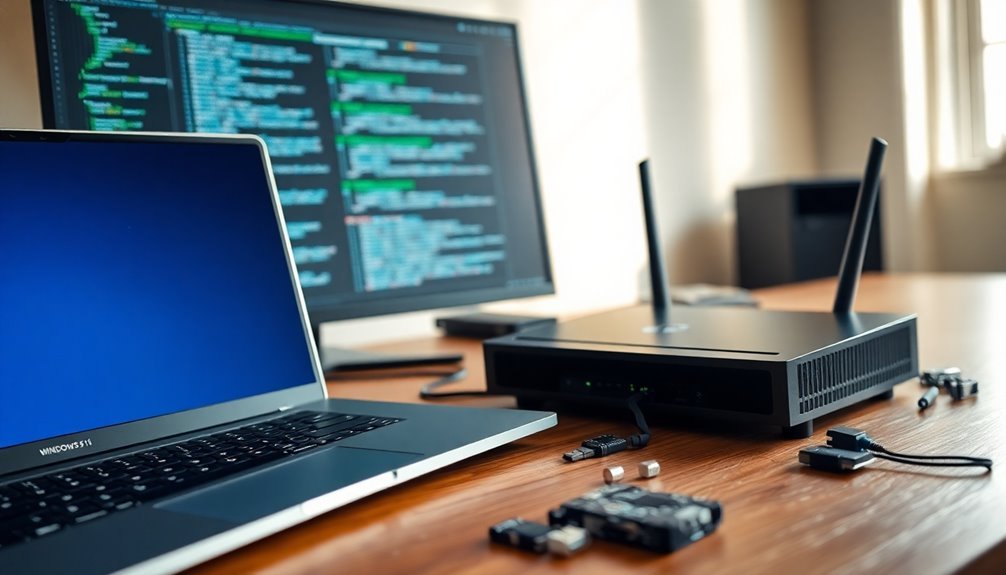
Optimize Your WiFi 6 Speed: Key System and Software Tips
Maximizing your WiFi 6 performance goes beyond having compatible hardware—system settings and software play a crucial role in achieving top speeds. In Windows 11, power plans significantly impact network throughput. Avoid using High or Ultimate Performance modes, as these can throttle WiFi 6 speeds to less than 1 Mbps.
Instead, select the Balanced power plan to ensure consistent and reliable network performance without system-level overrides that ignore your adapter settings.
Keeping your WiFi 6 adapter drivers up-to-date is essential for optimal speed. Check Device Manager to confirm your adapter is recognized and running the latest driver version. Always download drivers directly from your device manufacturer (OEM) or chipset vendor to prevent compatibility issues.
Outdated or incorrect drivers can lead to protocol negotiation failures and reduced throughput, even if your hardware supports WiFi 6.
For maximum wireless performance, set your adapter’s transmit power to the highest level and disable any power-saving features. Keep in mind that Windows may still enforce its own power policies, so regular monitoring is necessary.
Additionally, use Task Manager’s network tab to identify and limit bandwidth-heavy background applications or Windows Update processes. This helps preserve your WiFi 6 bandwidth for primary tasks, ensuring you get the fastest and most reliable wireless connection possible.
Troubleshooting Hardware and Compatibility Issues
Troubleshooting WiFi 6 Performance Issues on Windows 11: Hardware and Compatibility Solutions
If you’re experiencing WiFi 6 performance problems on Windows 11 despite proper system and software setup, it’s crucial to perform targeted hardware and compatibility troubleshooting.
Start by ensuring your WiFi 6 adapter drivers are fully updated. Check the driver version and release date against the manufacturer’s latest updates. If Windows 11 installs a generic driver automatically, uninstall it and reinstall the official OEM or Intel drivers to fix common errors like Code 31 and other driver-related issues.
Next, optimize your network adapter’s advanced settings. Adjust the “Wireless Mode” and “Roaming Aggressiveness” options to maximize throughput. Disable power management features that allow Windows to turn off your WiFi adapter to prevent connectivity drops.
Also, verify your router’s firmware is current and that its WiFi 6 capabilities are fully compatible with Windows 11. Configure router settings such as channel width, band steering, and security protocols to enhance compatibility and network stability.
For persistent WiFi 6 issues, perform a cold reboot of your PC to clear hardware memory states. Consider updating your BIOS or UEFI firmware to resolve any chipset and adapter conflicts.
If problems continue, hardware failure or device limitations may be the cause—replace outdated or malfunctioning components to restore optimal WiFi 6 performance on Windows 11.
Using Diagnostic Tools to Identify and Resolve WiFi 6 Problems
If you’re experiencing ongoing WiFi 6 performance problems, using powerful diagnostic tools can help you quickly identify and fix the root causes.
Start by downloading WiFi Analyzer from the Microsoft Store or similar WiFi channel scanning apps to detect wireless interference and channel congestion. These tools provide detailed visualizations and recommend the best channel settings, which is essential for improving WiFi 6 connectivity in busy environments.
For advanced troubleshooting, use NetSpot’s Survey Mode to generate WiFi signal heat maps and Inspector Mode to capture detailed network snapshots. Additional tools like Xirrus Wi-Fi Inspector and WifiInfoView help uncover overlapping networks, signal inconsistencies, and hidden access points that may affect your WiFi 6 performance.
Before diving into advanced diagnostics, leverage Windows 11’s built-in Network Troubleshooter and command-line utility (`netsh wlan show networks`) to gather basic network information or reset your network adapters.
Running WifiDiagnosticsView allows you to log connection events and identify recurring WiFi 6 failures. To resolve common DNS-related WiFi 6 issues, flush your DNS cache and switch to reliable public DNS servers such as Google DNS (8.8.8.8) or Cloudflare DNS (1.1.1.1).
Implementing these troubleshooting steps will enhance your WiFi 6 experience and ensure stable, high-speed wireless connectivity.
Frequently Asked Questions
Can Wifi 6 Improve Online Gaming or Streaming on Windows 11?
Yes, you can experience improved online gaming and streaming on Windows 11 with WiFi 6. You’ll benefit from higher speeds, lower latency, better congestion handling, and more stable connections—especially if you optimize router placement and update device drivers.
Is Wifi 6 Backward Compatible With Older Wifi Devices?
Think of WiFi 6 as a universal translator—you can connect your older WiFi devices seamlessly. You won’t access WiFi 6’s advanced features, but you’ll still maintain reliable connectivity, thanks to full backward compatibility with previous protocols.
Does Wifi 6 Impact Battery Life on Laptops Running Windows 11?
Yes, WiFi 6 impacts battery life on Windows 11 laptops. You’ll see longer battery runtimes when power-saving features like Target Wake Time are active, but heavy usage or aggressive power settings can throttle WiFi speed to conserve energy.
Are There Security Advantages to Using Wifi 6 on Windows 11?
Imagine you’re handling sensitive emails at a café—WiFi 6 on Windows 11 uses WPA3 encryption, so even if someone tries intercepting your data, stronger protocols like WPA3-Personal and encrypted management frames keep your connection secure.
What Is the Difference Between Wifi 6 and Wifi 6E on Windows 11?
You’ll notice Wi-Fi 6E on Windows 11 adds support for the 6 GHz band, providing faster speeds, lower latency, and less congestion than Wi-Fi 6’s 2.4/5 GHz bands. You’ll need compatible hardware to access these benefits.
Conclusion
While the promise of WiFi 6 is blazing speed, the reality on Windows 11 can be frustratingly slow if you overlook key updates and settings. By juxtaposing systematic troubleshooting—like updating drivers and optimizing router configs—against guesswork, you guarantee consistent, protocol-level performance gains. Don’t settle for intermittent bursts when you can achieve steady, high-throughput connections. Tackle both hardware and software variables methodically, and you’ll transform sporadic WiFi 6 issues into a streamlined, high-efficiency wireless experience.


